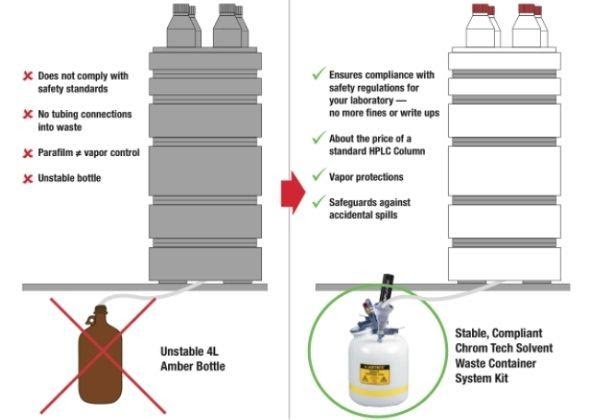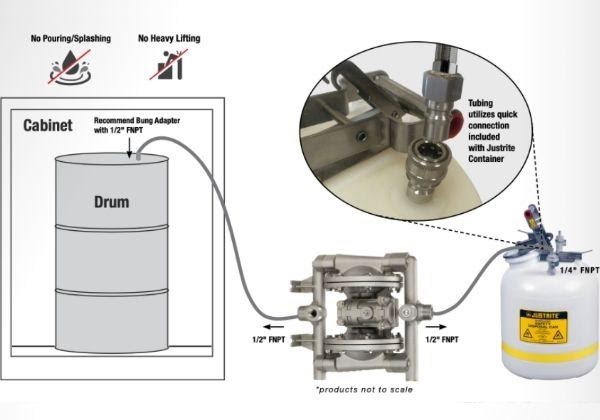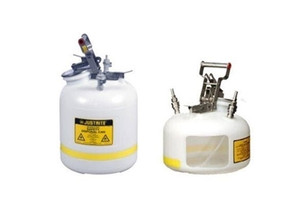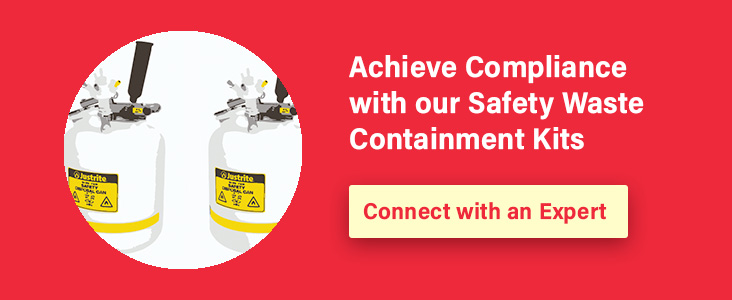19th Dec 2024
How Do You Dispose of HPLC Waste?
High-Performance Liquid Chromatography (HPLC) is a widely used technique across various industries for separating complex mixtures of known or unknown analytes into individual components. By utilizing internal or external standards, analysts can obtain both qualitative (what is it?) and quantitative (how much?) information about their samples. However, this process generates hazardous solvent waste that must be disposed of safely. In this blog, we will explore an easy solution for collecting HPLC solvent waste, along with bonus tips for those working in high-throughput laboratories.
Before We Discuss HPLC Waste, Let’s Step Back and Discuss the Components of an HPLC System

HPLC systems consist of an HPLC Pump that moves solvent (typically hazardous/flammable) from a solvent reservoir bottle through the entire system. The solvent flows through the system in HPLC and is, therefore, referred to as the mobile phase. After the HPLC pump is the injection valve, which is where the sample is introduced into the mobile phase stream. From there, the mobile phase moves the sample into the HPLC Column. The HPLC column is the heart of the chromatography system and where the separation of the complex mixture occurs. The analytes will flow through the HPLC column at different rates based on their interaction with the HPLC column’s stationary phase. After the HPLC column, the sample (and mobile phase) will flow through the detector. There are many types of detectors in HPLC, but in simple terms, the detector is responsible for “seeing” the sample that is being carried along by the mobile phase and sending a signal to a data system to create the chromatogram.
After the solvent has carried the sample through the HPLC system, everything ends up in the HPLC Waste Reservoir. A proper HPLC waste reservoir safely collects the mobile phase and sample components after they pass through the detector. Over my career, I have been in many labs with waste solvent flowing into repurposed 4L amber solvent bottles. Sometimes, the tubing is held in place with some parafilm. Sometimes, the bottle is sitting on the floor inside a secondary container (large plastic bin)—but sometimes not. My first question when seeing this is, “Have you been written up by safety (EHS) for your solvent waste?” And most often, the answer is, “Yes, but I don’t know what to do about it….”
Chrom Tech Has a Solution for HPLC Solvent Waste

Hazardous waste regulations require hazardous waste containers to be closed and sealed, except when adding or removing waste. I can tell you from the labs that I have seen in person that this is not always the case. Improper collection and handling of hazardous waste pose risks to humans and property. We encourage all labs to adopt safe HPLC chemical waste disposal solutions to minimize these risks.
We recommend the Justrite HPLC safety disposal cans, which have two quick-connect fittings (one intake and one vent). One quick-connect fitting we recommend is the 6-port manifold. The 6-port manifold uses HPLC fittings to plumb the outlet tubing from the HPLC system into the disposal can. Because we typically recommend a 6-port manifold, multiple HPLC systems can be plumbed into one waste container. An activated carbon
vapor filter can be attached to the second quick-connect fitting to capture harmful chemicals from escaping into the lab. The filters need to be replaced periodically, depending on the solvent waste composition (in our experience, most labs replace every three to six months).
The Justrite HPLC safety disposal can is made of a translucent polyethylene container, which allows for quick visual determination of the liquid level. The pouring spout is equipped with a stainless-steel flame arrester, which reliably dissipates heat to prevent flashback ignition (remember, HPLC solvents are often flammable). The spring-loaded, sealed lid automatically vents to guard against explosion. Even when using the Justrite HPLC safety disposal can, secondary containment is recommended. Most people running HPLC systems can likely remember a time when they overflowed the HPLC Waste container, and if it hasn’t happened to you yet, congratulations!
When using the Justrite HPLC safety disposal cans with the quick connect system, if you overflow the can, the good news is that your waste will not back up into the HPLC system. The overflow waste will go out through the Vapor filter (which will then need to be changed if this happens) and into your secondary container.
My HPLC Waste Container Is Full, Now What?
Now that the HPLC safety waste container is full, disconnect the waste container from the HPLC System. Since the Justrite containers utilize quick-connects, it’s as easy as the push of a button. Once the manifold is disconnected from the quick-connect, the container is automatically sealed to prevent spills. From there, waste from the container should be transferred into an appropriate container for removal from the building. Remember, when transferring flammable solvent waste, you must protect yourself from sparks. Use antistatic wires to prevent sparks from static electricity generated by the movement and flow of flammable liquids. During waste collection operations, use one antistatic wire to bond from a safety container to a receiving vessel, such as a funnel; then, properly ground by attaching a second antistatic wire to the drum and then to an earth ground.
I Have a Lot of HPLCs, Is There a Better Way to Transfer Hazardous Waste from the HPLC Waste Container to a Drum?
We make waste disposal SAFE and EASY with the All-Flo air-operated diaphragm pump; there is no electricity, which eliminates the risk of sparks. Simply plumb static conductive tubing on the inlet of the pump and permanently attach the Justrite quick connect. Therefore, the pump is always ready to quick-connect to your Justrite Safety Container. Permanently plumb the outlet of the All-Flo pump using static conductive tubing (PTFE lines SS braided Swagelok tubing) to your drums bung adapter (we recommend ½” FMNT fitting bung adapter).
Tech Tip: When your waste container is collecting waste (and NOT connected to the air operated pump), the solvent pickup adapter should be left off of your waste container. This is because your waste container is technically not a closed system. The adapter piece holds the quick connect piece "open" to the surroundings. Please note, the other quick connects are closed when the filter and manifolds are attached.

Conclusion
At Chrom Tech, we want to help you keep your lab personnel safe. Contact Chrom Tech to discuss HPLC Safety Waste Container Systems that are best suited for your laboratory needs.


